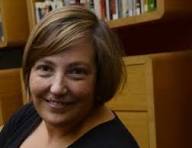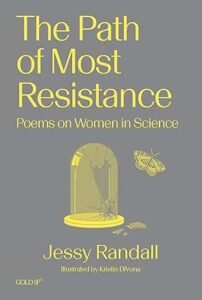Lost (and found) in the lab
A book of poems about notable, though often neglected, women in science
A book of poems about notable, though often neglected, women in science
I feel a little bad admitting this, but I laughed out loud while reading the opening stanzas of a persona poem about American botanist Jane Colden: “I married late. / Before walking down the aisle / at the advanced age of thirty-five…”

Jessy Randall
If you’re looking for poetry that’s profound but also accessible, Jessy Randall’s latest collection, The Path of Most Resistance: Poems on Women in Science, offers, in chronological order, 42 pithy profiles of important women in STEM (i.e. science, technology, engineering and mathematics).
The collection is the second in a series by Randall, an archival librarian at The Colorado College and an accomplished poet with nine published volumes. The first in this series, Mathematics for Ladies, was published in 2022.
As often as they make you laugh, Randall’s words in The Path of Most Resistance will have you searching for a pillow to scream into. The first line of the first poem sets the stage: “All that’s left of me is my name,” says Tapputi-Belatekallim, circa 1200 BCE, one of the world’s first recorded chemists.
Too many brilliant women have been tossed from recollection like crumpled-up tissues. Or as English botanist Anna Atkins puts it, “and my book hides my name. / Anna becomes, on the page, / anonymous.”
Randall’s free verses land like water molecules on the skin—light and chill-inducing. The tension between the book’s content and the poet’s beautiful delivery seems to somehow parallel a deeper strain many of the narrators grapple with when recounting their life stories. The vast majority of Randall’s poems are written in first person, though there are a few abrupt exceptions, including an account of mathematician Dorothy Bernstein.

Available through your local independent bookseller or at Bookshop.org
With Margaret Kivelson and Ellen Amanda Hayes, you get the sense that the scientists might actually be talking about themselves in the third person. Generally speaking, though, the “I” tells her story, a tactic that feels brave given the number of biographies in the collection. Individual struggles easily evoke universal themes, and Randall manages to differentiate her narratives enough to placate a picky reader.
Still, all the women are connected in a central way, by the voice of the poet and, in some cases, by their shared experience of going largely unrecognized.
You’ll recognize some names. Hello, former NASA astronaut Mae Jemison, who “had eight weightless days / and so much to prove,” and beloved environmentalist Rachel Carson, wondering in her monostich, “Why isn’t there a movie about me?” Most of the women I’d never heard of, like the 20th-century neurobiologist who “studied nerves to avoid nervousness.” I was eager to learn more.
Last year I took an adjunct position teaching writing to undergraduate students at Colorado School of Mines, a public research university in Golden focused on science and engineering. The gender distribution at Mines (67.9 percent male; 32.1 percent female) roughly mirrors national career trends. According to Clara Piloto, senior director of global programs at MIT Professional Education, women comprise about 28 percent of the nation’s STEM workforce.
Randall’s narrators put this reality under the proverbial microscope. I smiled when women broke from cultural norms—when they’d “go home muddy, leaving a trail / like rabbit tracks across the parlour [sic] floor.” And I had such fun learning about Randall’s subjects that I spent nearly two weeks reading this short collection, looking up narrators as I went. I started to suspect this was all part of Randall’s grand plan. She provides just enough interesting detail to compel us to conduct our own research.
The notes at the end of the book shed light on a few women in STEM, but you might also want to have Google handy. Randall’s poems are more about mood than plot, and the imagery is so vivid that the reader sometimes feels “suspended, like fruit in gelatin.” That said, you’ll notice a few connections between modern scientists. There’s Rachel Fuller Brown, the American chemist, for example, and her long-distance work with microbiologist Elizabeth Lee Hazen. “Together we got rich,” Brown proclaims at the end of her poem. The tone here reads more like a sigh being released than a brag.
Like Mae Jemison, I, too, found myself wondering, “What does this mean?” The tenacity of women in history ultimately left me feeling motivated, inspired and uplifted. “Will they perish, or rise up and fly?” I think you already know the answer.
Based near Denver, Jamie Siebrase is a journalist and the author of several Falcon guidebooks, including Hiking with Kids Colorado, Exploring Colorado with Kids and Mythbusting the Great Outdoors. She’s currently writing a guided workbook for those interested in using nature to access emotional healing.
Click here for more from Jamie Siebrase.

